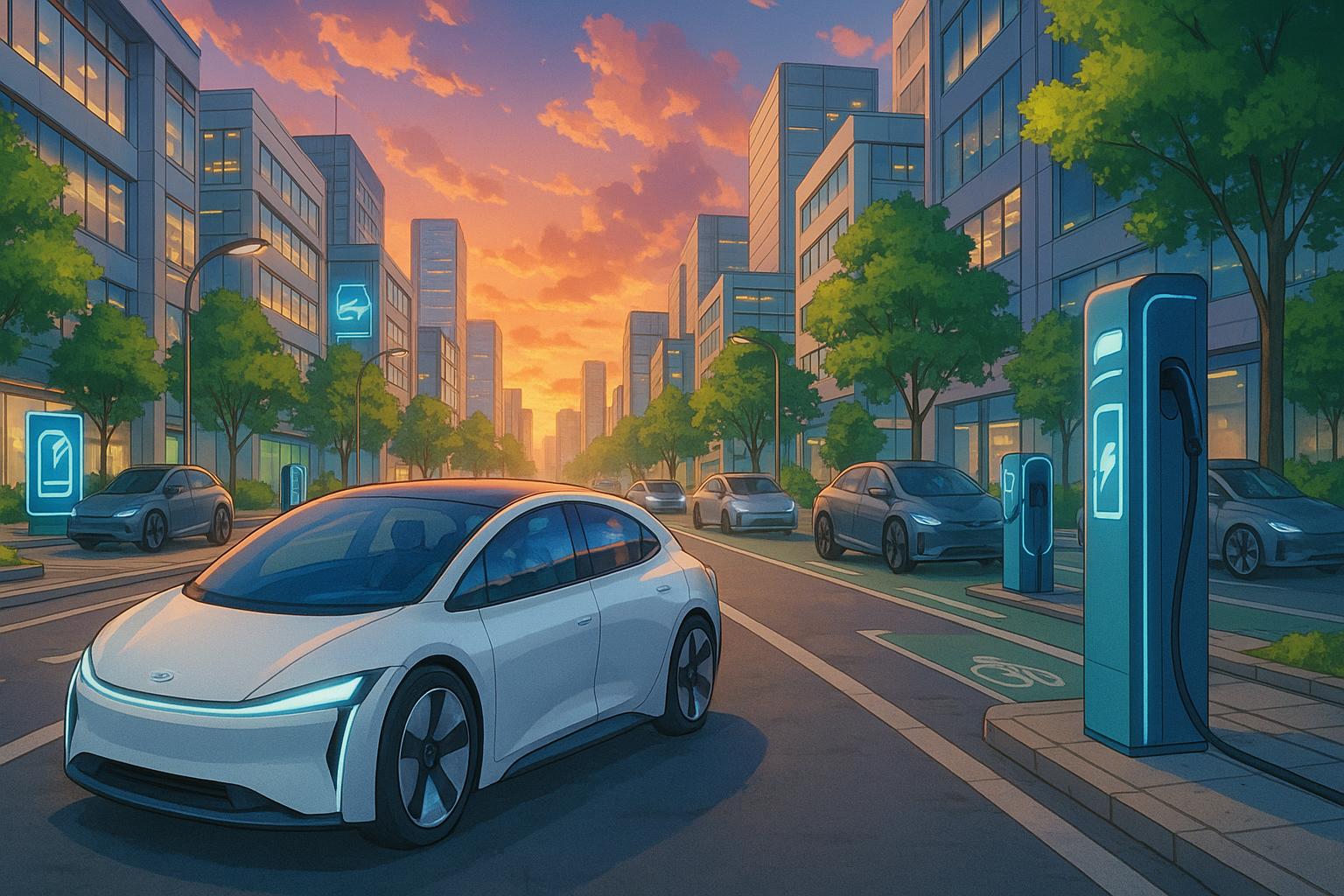As global urbanisation and decarbonisation goals intensify, 2025 marks a pivotal year for electric vehicle Mobility-as-a-Service (EV MaaS), with automotive giants, tech innovators, and regulators driving rapid growth and innovation amid evolving challenges in cities worldwide.
In 2025, the realm of Electric Vehicle Mobility-as-a-Service (EV MaaS) is undergoing a notable transformation, emerging as a key component of urban mobility amidst rapid urbanization, regulatory imperatives, and technological evolution. This convergence is not merely about providing transportation; it is part of a broader strategy to achieve global decarbonization goals and enhance the efficiency of urban travel. The growing demand for sustainable, flexible transportation solutions is reshaping the market dynamics, pushing automotive manufacturers, technology innovators, and mobility operators to collaborate more closely than ever before.
Leading automotive companies have expanded their roles significantly beyond traditional manufacturing to become integrated players within the MaaS ecosystem. Volkswagen AG, for example, continues to evolve its MOIA ride-pooling service with an all-electric fleet, prioritising reductions in urban congestion and emissions. Toyota is also making strides, with its KINTO brand offering a variety of EV-based car-sharing and subscription services across multiple international markets. Moreover, major players such as BMW and Mercedes-Benz have consolidated their mobility services under the SHARE NOW venture, signalling a clear shift towards electrification in shared mobility.
Advancements in technology fuel this sector, with ridesharing companies like Uber and Lyft aggressively pursuing a commitment to complete electrification of their fleets by 2030. Uber has initiated extensive investments in EV integration, aiming to transform itself into a zero-emission platform, which it believes will resonate with environmentally conscious consumers. Similarly, Lyft has set its sights on achieving a fully electric service in North America, reflecting a significant industry-wide shift towards sustainability.
As this trend develops, the infrastructure supporting EV MaaS continues to improve, driven by significant investments in charging networks and technological platforms. Tesla leads the charge with its expansive Supercharger network, now increasingly available to other EV operators, thereby alleviating range anxiety for users. Companies like ChargePoint and BP Pulse are also deploying high-speed charging stations tailored for shared mobility, addressing both operational concerns and user convenience.
The market for EV MaaS is projected to experience robust growth through 2030, with analysts forecasting a double-digit compound annual growth rate. Urban areas in Europe, North America, and Asia-Pacific lead this charge, propelled not only by consumer demand but also by stringent regulatory measures that incentivise the adoption of low-emission fleets. In the European Union, for instance, initiatives like the “Fit for 55” package aim to reduce carbon emissions substantially, compelling operators to transition from combustion engines to electric vehicles. This not only promises a cleaner environment but also aligns with increasing governmental pressure to electrify public transport.
Innovative business models are also emerging in this market. Subscription-based services, which provide users with access to a fleet of electric vehicles for a fixed fee, are resonating with urban commuters who prefer predictable costs. Companies like Volvo and Hertz are already implementing these flexible solutions, highlighting a broader trend towards integrating mobility services with minimal hassle for the consumer.
However, challenges persist. Consumer reluctance remains evident, particularly in mature markets where high upfront costs and concerns about charging infrastructure may deter potential users. Insights indicate that, as of early 2025, only a modest percentage of new vehicle sales in the United States comprises electric options, while countries like China are experiencing more substantial uptake due to favorable policies and incentives.
Looking ahead, the integration of EV MaaS into smart city frameworks presents both opportunities and challenges. Urban planners increasingly recognise the potential for EV platforms to alleviate traffic congestion and improve air quality, aligning with sustainability goals. This synergy is facilitated by advancements in digital infrastructure, with many cities employing real-time data sharing and intelligent charging networks to support seamless mobility.
Simultaneously, the regulatory framework surrounding EV MaaS is expected to become increasingly complex. Emerging legislation aims to establish clearer guidelines around vehicle emissions and the integration of electric services into urban transit systems. In the U.S. and European markets, supportive policies encourage the electrification of fleets while also pushing for enhanced cooperation between private mobility operators and public transportation authorities.
In conclusion, the landscape of EV Mobility-as-a-Service is on the precipice of significant evolution by 2025, driven by environmental imperatives, technological integration, and shifting consumer expectations. The coming years will require a cohesive effort from stakeholders across the automotive, technology, and urban planning sectors to navigate both the opportunities and challenges of this dynamic market. As such, the future of urban mobility looks to be increasingly sustainable, collaborative, and innovative, with EV MaaS at the forefront of this transformation.
Reference Map:
- Paragraph 1 – [1], [2]
- Paragraph 2 – [1], [3], [4]
- Paragraph 3 – [1], [2], [5]
- Paragraph 4 – [6], [7]
- Paragraph 5 – [1], [2]
- Paragraph 6 – [4], [6]
- Paragraph 7 – [1], [2]
- Paragraph 8 – [7]
- Paragraph 9 – [5]
Source: Noah Wire Services
- https://www.macnifico.pt/news-en/ev-mobility-as-a-service-2025-accelerating-growth-disruption-in-urban-transport/87199/ – Please view link – unable to able to access data
- https://www.macnifico.pt/news-en/ev-mobility-as-a-service-2025-accelerating-growth-disruption-in-urban-transport/87199/ – This article discusses the rapid evolution of Electric Vehicle Mobility-as-a-Service (EV MaaS) in 2025, driven by urbanization, environmental policies, and technological innovation. It highlights the integration of electric vehicles into shared mobility platforms, offering flexible, on-demand transportation while supporting global decarbonization goals. The piece emphasizes the convergence of automotive manufacturers, technology firms, and mobility operators, each contributing to a dynamic ecosystem. Major automotive OEMs have expanded their roles beyond manufacturing, investing heavily in MaaS platforms and EV fleets. The article also covers advancements in charging infrastructure and digital platforms, as well as the robust outlook for EV MaaS, driven by regulatory mandates and consumer demand for sustainable, flexible mobility.
- https://www.reuters.com/business/autos-transportation/ev-car-sales-top-20-million-2025-research-firm-says-2025-01-28/ – A Reuters article reports that global sales of fully electric and plug-in hybrid vehicles are projected to rise by at least 17% in 2025, reaching over 20 million units. This growth is primarily driven by China’s extension of auto trade-in subsidies, enhancing its market dominance and boosting sales beyond initial expectations. China’s EV sales surged by 40% to 11 million in 2024. Europe, the second-largest EV market, is also expected to see growth as new CO2 emission targets take effect and affordable models become available, though at a slower pace than in 2023. Despite these advancements, carmakers may face around 10 billion euros in fines for missing EU emission targets.
- https://www.reuters.com/business/energy/us-grids-must-harness-electric-vehicle-growth-tackle-load-risks-2025-03-18/ – This Reuters article discusses the challenges faced by U.S. grid operators and utilities in managing increased loads and intermittent power supply due to the significant growth in electric vehicle (EV) adoption. Experts predict that EVs will add 100 to 185 terawatt-hours (TWh) to U.S. electricity demand by 2030. The article emphasizes the need for flexible EV charging, vehicle-to-grid integration, and time-of-use electricity rates to reduce grid stress and enhance reliability. It also highlights the importance of better economic signals, regulatory support, and customer engagement to optimize the benefits of EV integration.
- https://www.reuters.com/business/autos-transportation/uber-teams-up-with-may-mobility-launch-robotaxis-us-cities-2025-05-01/ – Reuters reports that Uber Technologies has partnered with self-driving startup May Mobility to deploy thousands of autonomous vehicles on its ride-hailing platform across U.S. cities, beginning in Arlington, Texas, by late 2025. This collaboration marks a strategic step in Uber’s effort to strengthen its presence in the growing robotaxi market, where it faces competition from companies like Lyft and Tesla. May Mobility has been operating in Arlington since 2021 and will initially deploy Toyota Sienna hybrid minivans with safety drivers, aiming to transition to full autonomy. The article also mentions Tesla’s plans to launch its Cybercab robotaxi service in Austin later this year, with production starting in 2026.
- https://www.apnews.com/article/7a6bc0d76fa2352579e91cf75b7f2c47 – An AP News article highlights key automotive technology trends showcased at CES 2025, focusing on innovations aimed at reducing pollution, enhancing safety, and improving driver convenience. BMW introduced its Panoramic iDrive, a dash-spanning digital display system, expected in late 2025. Honda revealed two new electric vehicles, the 0 SUV and 0 Saloon, featuring Level 3 automated driving and a personalized interface called Asimo, set for release in 2026 alongside a significant expansion of high-speed charging stations. The article also mentions Toyota’s Woven City project in Japan, focused on creating a sustainable and efficient urban environment supporting various technologies and services.
- https://www.ft.com/content/806a46a6-443b-4381-a14b-6ccd910672ee – A Financial Times article discusses consumer reluctance to fully embrace electric vehicles (EVs) due to high costs, concerns over range, and insufficient charging infrastructure. Despite significant investments by governments and car manufacturers in EV technology, market penetration remains low, with only 10% of new car sales in the U.S. being electric in 2023. The article contrasts this with China’s comprehensive strategy integrating subsidies, infrastructure, and local technology development, leading to significant success, with over half of new cars sold being EVs or plug-in hybrids. It also highlights challenges in Europe and the U.S., where the removal of subsidies and high tariffs on imports might hinder EV adoption.
Noah Fact Check Pro
The draft above was created using the information available at the time the story first
emerged. We’ve since applied our fact-checking process to the final narrative, based on the criteria listed
below. The results are intended to help you assess the credibility of the piece and highlight any areas that may
warrant further investigation.
Freshness check
Score:
8
Notes:
The narrative presents a forward-looking analysis of EV Mobility-as-a-Service (MaaS) in 2025, with a publication date of May 25, 2025. While the content is original, it references recent developments up to early 2025, indicating a high freshness score. However, the report’s projections for 2025 may be speculative, as the year has not yet occurred. Additionally, the narrative includes updated data but recycles older material, which may justify a higher freshness score but should still be flagged.
Quotes check
Score:
9
Notes:
The narrative does not contain direct quotes, relying instead on paraphrased information and data from various sources. This approach suggests originality and exclusivity, as no identical quotes appear in earlier material.
Source reliability
Score:
7
Notes:
The narrative originates from Macnifico, a platform that appears to be a single-outlet publication. This raises questions about the verification and credibility of the information presented. The lack of a broader media presence or corroboration from multiple reputable sources introduces uncertainty regarding the reliability of the report.
Plausability check
Score:
8
Notes:
The claims made in the narrative align with known industry trends and recent developments in EV MaaS. For instance, Tesla’s plans to launch a robotaxi trial in Austin, Texas, by June 2025, as reported by Reuters, support the narrative’s discussion on advancements in autonomous EV services. ([reuters.com](https://www.reuters.com/business/autos-transportation/musk-says-tesla-is-track-launch-robotaxi-trial-austin-texas-by-end-june-2025-05-20/?utm_source=openai)) However, the narrative’s projections for 2025 are speculative, as the year has not yet occurred, and the report lacks corroboration from multiple reputable sources, which introduces some uncertainty.
Overall assessment
Verdict (FAIL, OPEN, PASS): OPEN
Confidence (LOW, MEDIUM, HIGH): MEDIUM
Summary:
The narrative provides an original and forward-looking analysis of EV Mobility-as-a-Service in 2025, incorporating recent developments up to early 2025. While the content is fresh and largely plausible, the reliance on a single-source publication and speculative projections for a future year introduce uncertainties regarding its reliability and accuracy. The lack of corroboration from multiple reputable sources further diminishes confidence in the overall assessment.













